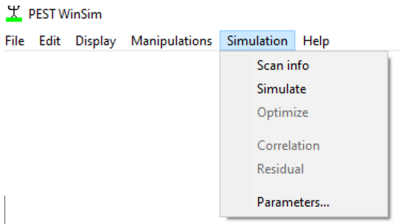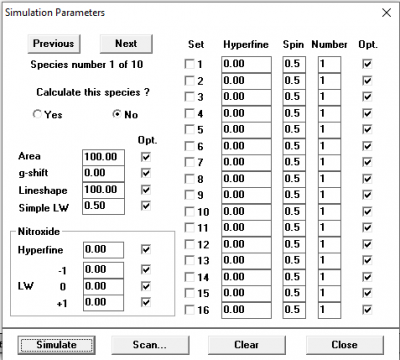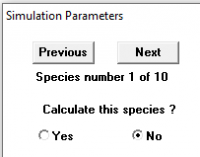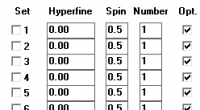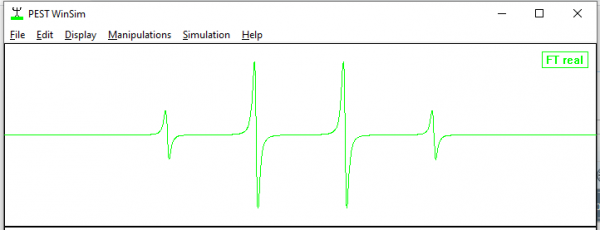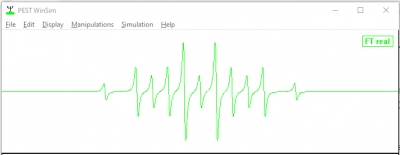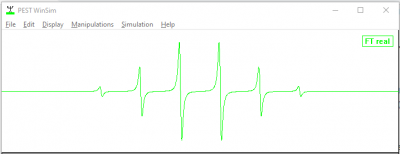WINSIM
History
Simulation of Multiple Isotropic Spin-Trap EPR Spectra
Installing WINSIM
Public Electron Paramagnetic Resonance Software Tools
Running a WINSIM Simulation
This is the main menu bar...
WINSIM will allow you to import an EPR data file to display along with the simulated data. In this first example, we are going to do simulations only; first select the "parameters" item under the "Simulation" tab...
Parameters
The above panel is were all simulation parameters are input. Please note the following:
- 1) This program can simulate up to 10 radicals in one EPR spectrum. It is very rare to have more than one radical in a spectrum, but there are cases where there is a background signal as well as a signal of interest, so...2 radicals...sometimes. To start the simulation you must select "YES"...calculate this [1] species...
- 2) On the right side of the parameters panel is where you enter the EPR parameters:
- Set: each type/set of spins has their own parameters. For example in methane, CH4, there is only one set of protons.
- Hyperfine: this is a term which indicate the "energy" of interaction between a nuclear spin and the unparied electron.
- Spin: this is the nuclear spin.
- Number: how many spins are in this set
- Opt: when fitting experimental EPR data an optimization routine can be run, this is where you select whether you want to optimize this parameter or not.
Simulation 1
Run a simulation for the methyl radical, CH3. (set 1 - check, hyperfine 15 G, Spin - 0.5, Number - 3, opt - leave as checked (but not used), click "Simulate" (bottom left)...
- Sim 1 follow up...for educational purposes follow these instructions:
- - change the Number to 1, and simulate...you will now see only 2 lines, displayed in a "first-derivative" signal (typical in EPR due to the detection system). The separation between these two line is 15 G (Gauss).
- - Change the Number to 2, and simulate...you will now see 3 lines all separate by 15 G.
- - Change the Number to 3, and simulate...you will now be back to the original EPR simulation of methyl radical; 4 lines all separate by 15 G.
Simulation 2
Run a simulation for the ethyl radical, CH3-CH2....are all of these protons the same? You would need to collect the EPR signal for this radical and see if the hyperfine was the same for the protons:
- If they are different, then the simulation could be setup as...
- - set 1 - check, hyperfine 12 G, Spin - 0.5, Number - 2, opt - leave as checked (but not used),
- - set 2 - check, hyperfine 8 G, Spin - 0.5, Number - 3, opt - leave as checked (but not used),
- - click "Simulate"...
- If they are all the same, then the simulation would be setup as...
- (Note: for ease of setup, the simulation is still using 2 sets, but they have the same parameters, same as only 1 set with 5)
- - set 1 - check, hyperfine 10 G, Spin - 0.5, Number - 2, opt - leave as checked (but not used),
- - set 2 - check, hyperfine 10 G, Spin - 0.5, Number - 3, opt - leave as checked (but not used),
- - click "Simulate"...
EPR Interpretation
The analysis of EPR spectra has been made considerably easier using the WINSIM (or similar) simulation software. Below are a set of EPR spectra (some simulated and some experimental) to be used to practice interpreting EPR data.
EPR Literature
Ascorbate Radical
Hydroxyl Radical
THE ORIGIN OF THE HYDROXYL RADICAL OXYGEN IN THE FENTON REACTION - 17O data


